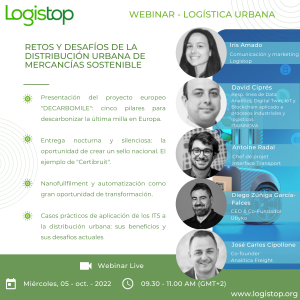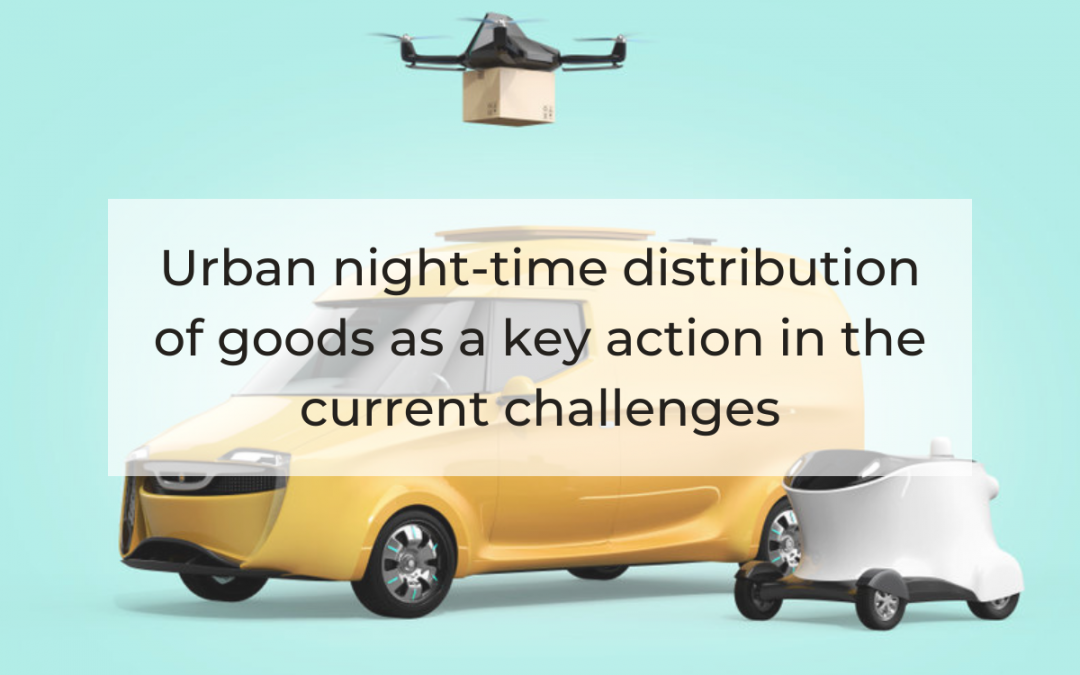- The search for a sustainable urban distribution model for goods requires a redesign of urban logistics.
- The main challenge is to try to reduce carbon emissions within cities.
- Urban night-time freight distribution should be accelerated through the creation, for example, of a national label.
In the Logistop Webinar “Challenges of Sustainable Urban Distribution of Goods“, the main challenges facing urban distribution were presented and analysed, identifying different alternatives and success stories that can respond to them.
Urban distribution is one of the most critical links along the supply chain. In addition to the need to deliver products in the right place at the right time, there is also the challenge of doing so in a sustainable way. This implies the development of new processes and forms of delivery that have a direct impact on the way this activity is carried out, requiring the development of innovative solutions to respond to customer needs.
To analyse these issues we had the participation of David Ciprés, Head of the Data Analytics, Digital Twin, IoT and Blockchain applied to industrial and logistics processes line, ITAINNOVA, Antoine Radal, Project Manager, Interface Transport, Diego Zúñiga, CEO & Co-founder, Ubyko, and José Carlos Cipollone, Co-founder, Analítica Freight, as well as the presentation o Iris Amado, Communication and Marketing, Logistop.

Five key elements to decarbonise the last mile in Europe
Through the Decarbomile project, David Ciprés analysed the five pillars that are being worked on within the framework of this project with the aim of trying to reduce carbon emissions within cities: 1) collaboration; 2) redesign of business models; 3) integration and management of common spaces; 4) regulation; and 5) digitalisation.
As highlighted by Ciprés, this project will carry out an analysis of the social, economic and environmental impact, also addressing regulatory aspects, with the aim of improving the urban distribution of goods in the pilot cities (Logroño, Nantes, Istanbul and Hamburg), making it increasingly efficient and collaborative.
“We must identify and analyse the advantages and opportunities that collaboration offers in order to be able to modify business models. This modification of established models will allow us to make collaboration more effective and make last mile distribution more sustainable”
David Ciprés, Head of Data Analytics, Digital Twin, IoT and Blockchain applied to industrial and logistics processes, ITAINNOVA
Night and silent delivery: the opportunity to create a national label
For his part, Antoine Radal highlighted the role that night-time urban delivery should play as an important action to respond to the challenges that exist today, accelerating the implementation of this good practice by creating, for example, a label that would allow a unified framework to be established at national level, as is already the case in countries such as France.
Radal highlighted the interest and advantages that night-time deliveries can bring in operational, energy, environmental, social and economic terms. However, it is necessary to implement a series of measures and adaptations that will require investment by shippers, shops and logistics operators, as well as collaboration between public and private actors to guarantee the success of this development.
To exemplify what he said in his speech, Radal explained the “Night deliveries respectful of neighbours and the environment” label created by the Certibruit© association (France) in 2012 with the aim of formalising a common framework for night and silent deliveries in cities.
“Urban night-time distribution of goods already exists, but it is a very important action to respond to the existing challenges. In Spain it has existed for several years, but it is necessary to identify and analyse how this good practice can be accelerated through the creation of a label that allows a unified framework to be defined at national level”
Antoine Radal, Project Manager, Interface Transport
Nanofullfilment and automation as a major transformation opportunity
Diego Zúñiga then highlights, among other aspects, the importance that the consumer has (and will have) in defining the models of urban distribution of goods that will triumph in the coming years.
The current and future society, more liquid and demanding, together with the concept of smartcity, with more human and pedestrian cities, will determine urban logistics based on four key aspects: 1) more logistical delegation to the user; 2) automation; 3) anticipation; and 4) capillarity and proximity.
Urban logistics in general, and urban distribution of goods in particular, will undergo major changes in the next 10 years. Pedestrianisation and the need for faster deliveries will force ecommerce to re-stock stock within the city before the moment of purchase. A final leg will be added within the central core from the night-fed nanofulfillment to the end user. In a much more competitive scenario, the future will be for those who take advantage of predictive capability by anticipating the purchase and stocking close to the shopper. This will be the only way to deliver quickly, ecologically and economically. In addition, by offering automatic and nearby nodes, it will be the end consumer himself who will actively participate in logistics, opting for alternatives to home delivery.
“Nowadays, unlike in the past, competition is greater and society is more liquid, and it is consumers who determine which models and companies succeed. The aspects most valued by young people in terms of distribution are flexibility and speed, and it will be those models and companies that best adapt to these needs that will be the winners”
Diego Zúñiga, CEO & Co-founder, Ubyko
Case studies of the application of ITS to urban distribution: its benefits and current challenges
Finally, José Carlos Cipollone analysed the current panorama of urban logistics, which faces the global challenge of achieving sustainability, in parallel, in its three dimensions: economic (meagre margins), environmental (high emissions) and social (informality, illegality, accidents). Some of the main barriers to the transformation of goods mobility in cities are: 1) under-dimensioned institutional framework; 2) inadequate infrastructure; 3) low public awareness; and 4) lack of data on urban logistics.
Following the analysis of these existing problems, Cipollone presented some examples of successful cases of good practices that have been developed in Barcelona, Australia and Latin America that have improved the problems that had previously been detected in relation to the urban distribution of goods.
In conclusion, Cipollone stressed that we will only have the information and data necessary for the implementation of innovative solutions as the digitisation of urban logistics progresses.
“The main barriers to the transformation of freight mobility in cities are: 1) under-dimensioned institutionality; 2) inadequate infrastructure; 3) low public awareness; and 4) lack of data on urban logistics”
José Carlos Cipollone, Co-founder, Analítica Freight
About Logistop
Logistop is the benchmark workspace for collective innovation through the realisation of projects hand in hand with our members. Transforming the entire supply chain into a more efficient and sustainable one. All this with the aim of articulating and carrying out innovation projects among the members, without excluding the possibility of collaborating with or receiving support from certain organisations outside Logistop.

